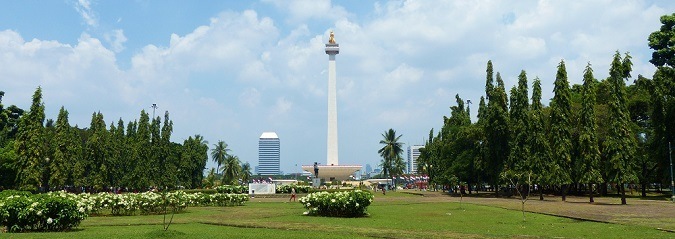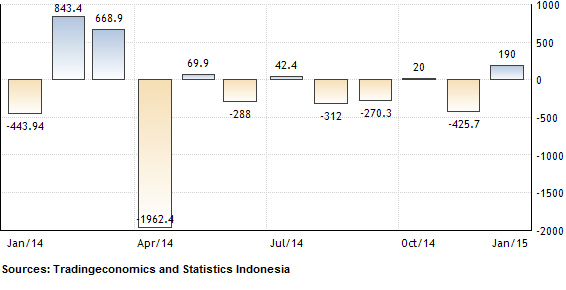Macroeconomy Indonesia: Inflation, Trade Balance and Manufacturing
Indonesia’s inflation eased significantly in January 2015 to 6.96 percent year-on-year (y/y) from 8.36 percent (y/y) in December 2014 as the government’s January fuel price cut translated into lower transportation costs across Southeast Asia’s largest economy. In January, the Joko Widodo administration cut fuel subsidy spending and moved a step closer to a full market-based price mechanism for low-octane gasoline and diesel. As a result - amid low global oil prices - prices of diesel and gasoline fell by an average of 14 percent.
The impact of lower fuel costs was immediately felt as the transportation, communication and financial services sector deflated by 4.04 percent in January. Indonesia’s core inflation, which excludes prices of volatile products and government-administered prices, was 4.99 percent in January, up slightly from 4.93 percent in the previous month due to higher minimum wages.
With month-on-month deflation of 0.24 percent in the first month of 2015, voices were heard to reduce the relatively high interest rate environment in Indonesia. The central bank (Bank Indonesia) currently has its key benchmark rate (BI rate) at 7.75 percent. However, it is unlikely that the institution will soon lower its BI rate as the country is still coping with a wide current account deficit (about 3 percent of GDP) and needs to have an attractive rate in order to mitigate potential capital outflows ahead of a looming US interest-rate hike.
Inflation in Indonesia:
| Month | Monthly Growth 2013 |
Monthly Growth 2014 |
Monthly Growth 2015 |
| January | 1.03% | 1.07% | -0.24% |
| February | 0.75% | 0.26% | |
| March | 0.63% | 0.08% | |
| April | -0.10% | -0.02% | |
| May | -0.03% | 0.16% | |
| June | 1.03% | 0.43% | |
| July | 3.29% | 0.93% | |
| August | 1.12% | 0.47% | |
| September | -0.35% | 0.27% | |
| October | 0.09% | 0.47% | |
| November | 0.12% | 1.50% | |
| December | 0.55% | 2.46% | |
| Total | 8.38% | 8.36% | -0.24% |
Source: Statistics Indonesia (BPS)
Inflation of Indonesia 2008-2014:
| 2008 | 2009 | 2010 | 2011 | 2012 | 2013 | 2014 | |
| Inflation (annual percent change) |
9.8 | 4.8 | 5.1 | 5.4 | 4.3 | 8.4 | 8.4 |
Sources: World Bank
Indonesia’s January 2015 Manufacturing Activity
Manufacturing activity in Indonesia fell for the fourth consecutive month in January 2015. On a positive note, the decline was at a slower pace thus signalling that the performance may be stabilizing. Based on the HSBC Markit purchasing managers’ index (PMI) Indonesia’s manufacturing activity grew to 48.5 from 47.6 in December (which was a record low). A score below 50 indicates contraction.
Whereas new orders and output declined at slower rates, export orders fell at the sharpest rate since the survey commenced four years ago. HSBC economist Su Sian Lim said that “weak external demand continues to pose the largest drag, with the new export orders sub-component falling to a record low in January. Nevertheless there are still signs that, while manufacturing sector conditions are likely to remain soft in the coming months, the sector is stabilizing." Lim added that low global oil prices should help to boost the country’s manufacturing sector.

Indonesia’s December 2014 Trade Balance
Indonesia’s trade balance was better-than-expected in December 2014. Based on official data from Statistics Indonesia (BPS), the country recorded a USD $186.8 million trade surplus last month (improving from a USD $426 million deficit in the previous month). However, cumulatively, Indonesia posted a USD $1.89 billion trade deficit over full-year 2014, primarily due to the country’s wide trade deficit in the oil and gas sector.
In December the country’s exports rose 7.4 percent m/m to USD $14.7 billion on the back of improved demand for crude palm oil and coal. However, exports declined 13.8 percent on a year-on-year basis. Meanwhile, the country’s imports were up 2.8 percent m/m to USD $14.4 billion in December but fell 6.6 percent year-on-year.
Indonesia’s trade balance is not expected to improve markedly in the months ahead as China (the main trading partner of Indonesia) is experiencing an economic slowdown thus implying continued reduced demand from the world’s second-largest economy. Over 2014, Indonesia had to cope with a USD $14 billion trade deficit with China.
Indonesia Balance of Trade (in USD million):

